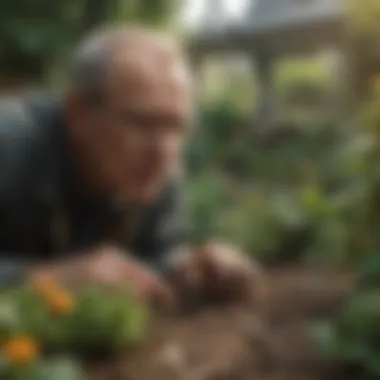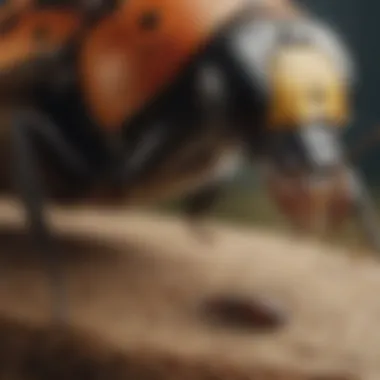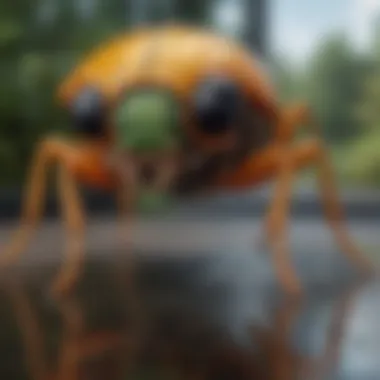Dan the Bug Guy: Mastering Pest Management Techniques


Intro
In the intricate tapestry of our ecosystems, pests often emerge as uninvited guests. They can disrupt the harmony of our homes and gardens, creating frustrations that range from mild annoyance to outright disaster. Yet, the understanding of these small creatures holds the key to effective pest management. This narrative aims to explore the expertise of Dan the Bug Guy, a well-versed professional in pest control whose techniques meld knowledge with actionable solutions for dealing with pests.
Engaging with pests in a more enlightened manner allows homeowners to approach pest management with intelligence and care. From defining what exactly constitutes a pest, to understanding their ecological role, Dan provides insights that elevate our relationship with nature. Additionally, his eco-friendly practices serve as a guiding light, steering us towards sustainable techniques that respect the environment and its integral residents.
With that in mind, let us journey through the various aspects of pest management, starting with the essential step of comprehending pests themselves.
Foreword to Dan the Bug Guy
The world of pest management is often filled with misconceptions and a fair bit of fear, mainly fueled by the uninvited guests that can invade homes and gardens. Here is where Dan the Bug Guy steps in, bringing not just his expertise but also a fresh perspective to pest control. Understanding Dan’s approach is vital for those juggling their household responsibilities while wanting to keep their living spaces safe and pest-free. His methods combine practicality with an in-depth understanding of insect biology, making him a trusted ally for homeowners.
Background and Qualifications
Dan’s journey into the world of insect control wasn’t something he stumbled into overnight. Rather, he built a solid foundation through years of diligent study and hands-on experience. Armed with a degree in entomology from a reputable university, he has a comprehensive understanding of both beneficial and harmful insects.
But education alone doesn’t make an expert. Dan dedicated a significant portion of his career working in various pest control companies. This time on the front lines taught him not just how to handle pests, but also how to interact with people. His approach is as much about educating homeowners as it is about eradication, making him a unique figure in the field of pest management.
Philosophy of Pest Management
Dan operates with a philosophy that favors balance over brute force. He doesn't just look to eliminate pests but seeks pathways to coexist. Understanding insects’ ecological roles while managing infestations is crucial to his strategy. One of his key principles is Integrated Pest Management, which emphasizes using a blend of biological, cultural, and mechanical control methods.
"Managing pests effectively requires respect for the delicate balance of the ecosystem. Not all bugs are enemies; some need our protection."
He often shares insights with his clients on how to make their environments less appealing to pests through simple changes in daily routines. By promoting awareness about keeping food sealed and maintaining clean surroundings, Dan not only addresses the issue at hand but also empowers homeowners with knowledge to prevent future infestations.
Through this combination of qualifications and a thoughtful, preventative approach to pest management, Dan the Bug Guy embodies an effective and modern philosophy that resonates well with those seeking to maintain their homes in harmony with nature.
Dan's expertise stands as a beacon, guiding house owners down the path of informed vigilant pest control.
The Importance of Pest Control
Pest control is not merely about keeping your home free from insects; it goes much further than that. As we dive into the intricacies of this domain, we discover how pest management plays an essential role not only in our health but also in the wider ecosystem and economic landscape. Poor pest management can lead to severe consequences that ripple through our daily lives.
Impact of Pests on Health and Environment
Pests like rodents, cockroaches, and mosquitoes aren’t just nuisances; they can be significant health hazards. Insects and rodents can spread diseases that impact not just the household, but entire communities. Take, for example, the common house mouse. These little critters carry bacteria that could cause serious illness, such as hantavirus and salmonella. A single mouse can contaminate enough food to make a family ill.
In addition, let’s consider the environmental aspect. While insects may seem like mere irritants, they are also a critical component of our ecosystem. Some pests, like certain beetles or moths, can harm plants that provide oxygen and food. The imbalance caused by uncontrolled pest populations can lead to a decline in native species, disrupting food chains further.
"Effective pest control is not just about eradication but about maintaining a healthy balance in nature."
Economic Consequences of Pest Infestations
The financial impact of pest infestations can be quite staggering, often overlooked until damage has been done. Homeowners face various costs, from emergency pest control services to repairs caused by pest-related damage. For example, termites can quietly eat away the structure of a house, leading to repairs that can run into thousands of dollars. If you ignore those little wood-destroyers gnawing at your beams, you might find yourself building up a costly repair bill in no time.
Businesses, too, feel the pinch. A pest-infested establishment can harm a company's reputation, leading to lost customers and revenue. Imagine dining at a restaurant only to spot a cockroach on the floor – likely, you would think twice before returning.
In addition to direct damage, there are hidden costs. For instance, if a business faces a pest issue, they may have to close their doors for fumigation, resulting in lost profits. Just like that, the financial implications of pest infestations extend beyond immediate repair costs, affecting the bottom line long-term.


In sum, understanding the importance of pest control is critical. It encompasses health and environmental well-being, along with economic viability. Ignoring these facets doesn’t just harm the individual but can set off a domino effect on the community and instincts. To neglect pest control is to invite chaos into homes and businesses.
Common Pests and Their Profiles
Understanding the various kinds of pests that can invade our spaces is a crucial element in effective pest management. This section aims to illuminate the significance of identifying common pests, as well as their habits and habitats, providing housewives and homeowners with practical knowledge to tackle infestations before they spiral out of control.
Identifying these pests not only aids in prevention but also enables homeowners to address pest issues swiftly and effectively. By shedding light on their characteristics, behaviors, and the potential harm they can cause, individuals can better arm themselves against these unwelcome invaders.
Identifying Household Pests
Household pests come in all shapes and sizes, and recognizing them can make a world of difference in managing infestations. Here are a few common culprits:
- Ants: Small but mighty, these pests can infest kitchens and pantries. They leave behind pheromone trails that can lead entire colonies directly to food sources.
- Cockroaches: Known for their resilience, cockroaches thrive in dark, damp environments. They can carry diseases, so prompt identification is crucial.
- Bed bugs: These tiny parasites may be hard to spot but can wreak havoc on sleep patterns. Their bites can lead to severe itching and discomfort.
- Rodents: Mice and rats not only nibble on food but also pose significant health risks through contamination and disease transmission.
Familiarizing yourself with these pests can help you spot early signs of an infestation. Look for droppings, gnaw marks, or nests as indicators of unwanted guests.
Garden Pests: Threats and Solutions
Garden pests can be a real headache, particularly for those who take pride in their outdoors. Recognizing these threats early can save a lot of grief. Some frequent visitors include:
- Aphids: Small and sap-sucking, aphids can weaken plants. They often cluster on young shoots and leaves, causing deformation and stunted growth.
- Slugs and snails: These slimy foes feast on tender plants and can practically decimate a garden overnight.
- Japanese beetles: Their shimmering bodies might be visually appealing, but they can munch their way through foliage, leaving a trail of destruction.
To combat these pests, consider eco-friendly solutions such as:
- Natural predators: Introduce beneficial insects like ladybugs that prey on aphids.
- DIY traps: Set up beer traps or baited containers for slugs and snails.
- Companion planting: Certain plants repel pests; for example, marigolds can deter nematodes and aphids.
Effective pest management hinges on prompt identification and strategic responses; the sooner you act, the better.
By developing an understanding of common household and garden pests, homeowners can take proactive measures. In turn, this knowledge not only saves plants and household goods but contributes to a healthier living environment.
Effective Pest Control Strategies
In pest management, the strategies employed can make or break the success of protecting your home and health. Effective pest control strategies are akin to a well-timed dance; if one step is missed, the entire routine may falter. This section dives into the essential elements that form a successful pest control framework, highlighting the necessity for an informed and thoughtful approach to managing pest populations.
Integrated Pest Management Approaches
Integrated Pest Management (IPM) is a holistic approach that combines various strategies to effectively handle pest problems. Rather than relying solely on pesticides, IPM encourages the use of multiple tactics tailored to specific situations. Some major components of IPM includes:
- Monitoring: Keeping an eye on pest populations helps determine when control measures are required.
- Identification: Understanding the specific types of pests present guides the choice of control methods.
- Thresholds: Deciding when the presence of pests warrants action, helps prevent unnecessary interventions.
- Control Strategies: Using a mix of biological, cultural, mechanical, and chemical tactics, tailored to the situation at hand.
This strategy emphasizes prevention over reaction. By monitoring your environment and understanding insect behaviors, you can often avert infestations before they escalate.
Role of Chemical Solutions in Pest Control
While eco-friendly methods are continually gaining popularity, traditional chemical solutions still play a role in pest management. They are effective and, when used cautiously, can be safe. Here are some considerations:
- Targeted Chemistry: Newer formulations are designed to affect specific pests without harming beneficial insects.
- Residual Effects: Certain chemicals provide lasting control, reducing the frequency of applications needed.
- Professional Application: Engaging a pest control expert to apply these solutions can mitigate risks associated with improper usage.
Though chemical methods are a tool in the pest control kit, it's vital to know when and how they should be applied. Using them alongside other methods can provide a balanced approach to managing invading insects.
Eco-Friendly Alternatives and Practices


In a world increasingly leaning towards sustainability, eco-friendly pest control practices are becoming more significant. These methods not only help manage pests but also ensure the safety of your family and pets, as well as the environment. Here are some noteworthy eco-friendly options:
- Natural Predators: Encouraging beneficial creatures like ladybugs or lacewings helps keep pest numbers in check.
- Organic Treatments: Products like diatomaceous earth, neem oil, and insecticidal soaps can effectively combat pests without synthetic chemicals.
- Cultural Controls: Changing aspects of the environment, such as proper sanitation and habitat modification, deters pests naturally.
- Companion Planting: Specific plant combinations can repel pests and promote a healthy garden ecosystem.
Both homeowners and housewives can explore these strategies to manage pests in their lives effectively. By employing an assortment of control methods, it’s possible to create a sustainable ecosystem conducive to a pest-free home.
Remember: Pest management isn't just about eliminating pests; it's about creating a balance in your environment.
Dan’s Community Outreach Programs
Dan believes that a well-informed community is better equipped to handle pest-related issues. His outreach programs serve as a bridge between complex scientific knowledge and everyday practices beneficial for households and gardens. By bringing information directly to the people, he aims to demystify pest management and empower individuals.
Benefits of Community Outreach
These programs encourage proactive pest control measures that can prevent infestations rather than simply reacting to them. For instance, teaching homeowners how to identify pests early can make all the difference in managing a small problem before it escalates. Dan’s approach also fosters a sense of community responsibility, where everyone plays a part in maintaining a pest-free environment.
In addition, Dan’s outreach includes developing tailored educational resources suited for different demographics within the community. This could range from simple flyers for busy parents to detailed guides for elderly residents who might need more assistance. Having resources accessible in various formats ensures that no one feels left out of the conversation regarding pest management.
Educational Workshops and Resources
Dan conducts workshops at local community centers, libraries, and even schools. These educational sessions are not only informative, but they are also hands-on, where attendees can practice identifying pests using provided guides or tools. Dan emphasizes interactive learning, creating an engaging atmosphere where questions can be asked freely.
"By teaching people about pests, we also help them understand their behaviors and habitats," Dan often says. "Knowledge is the first line of defense."
He also distributes pamphlets and digital materials that include:
- Guides on recognizing common household pests
- Tips for maintaining a pest-resistant home or garden
- Information on eco-friendly pest management practices
- Resources for contacting pest control professionals when needed
Engaging the Public in Pest Awareness
Engagement is a critical aspect of Dan’s outreach. He uses social media platforms and local events to create dialogues around pest awareness. By using relatable language, he breaks down complicated ideas. His social media presence often shares quick tips, infographics, and videos that are easy to digest for anyone scrolling through.
Dan’s initiatives to engage include:
- Community Q&A Sessions: Regular online sessions where community members can ask any pest-related questions
- Homeowner Challenges: Encouraging homeowners to share their pest management successes or methods, fostering a supportive and informative environment
- School Programs: Interactive programs for students that teach the importance of pests in the ecosystem and responsible management
Through these avenues, Dan effectively brings awareness to an often overlooked topic, ensuring that pest management is not regarded solely as a chore but a crucial aspect of home and environmental care.
Debunking Pest Myths
Understanding pests and their behavior is often clouded by myths and misconceptions that can lead to fear and misunderstanding. This section highlights the significance of debunking such myths, as it educates homeowners and equips them with the knowledge needed to manage pest issues effectively. By stripping away the layers of misinformation, Dan the Bug Guy aims to foster an informed community who approach pest management with confidence and clarity.
Common Misconceptions about Pests
When we think about pests, a slew of beliefs can spring to mind, many of which are simply not true. A frequent misconception is that all insects are harboring diseases or are outright dangerous. In reality, numerous insects play a critical role in maintaining a balanced ecosystem. For instance, ladybugs, which some homeowners might hastily dismiss as mere nuisances, are actually beneficial predators of aphids and other pest insects.
Here are some key myths:
- All pests are harmful: Not all insects threaten human health or property. Many offer services like pollination, which is vital for our food supply.
- If I see one pest, there are many more: Just because a solitary spider might wander across your living room floor doesn’t mean you’ve got a full-blown infestation on your hands.
- DIY methods always work: While home remedies can be effective in certain situations, they are not universally applicable solutions and may sometimes aggravate the problem or lead to further issues.
It's crucial to separate facts from fiction when it comes to pest narratives. Trusting unfounded beliefs can lead to unnecessary anxiety and even misguided actions that can worsen pest situations.


The Ecological Role of Insects
The ecological significance of insects cannot be overstated. These creatures carry out essential functions that keep our environment healthy. Many people think of insects solely as pests, overlooking their roles in ecosystems.
Here’s a short rundown of their importance:
- Pollination: Insects like bees and butterflies are instrumental in pollinating plants. This process is vital for the production of fruits and vegetables.
- Soil Improvement: Earthworms and beetles help aerate and enrich soil, which fosters healthier plant growth.
- Decomposition: Insects such as ants and beetles contribute to breaking down dead organic material, recycling nutrients crucial for new growth.
"Insects are not just pests; they are the lifeblood of ecosystems, playing varied roles that ripple through the food chain."
Rethinking the habitation of insects brings about respect and appreciation for their ecological contributions. Recognizing their important roles can empower homeowners to take a balanced approach towards pest management, viewing them not solely as invaders but as co-inhabitants of our environment. By changing our perspective, we can foster a more harmonious coexistence with these essential creatures.
Future Trends in Pest Management
The realm of pest management is constantly evolving, driven by advancements in technology and shifting societal attitudes toward environmental sustainability. Understanding these future trends is paramount for homeowners and housewives alike, as this knowledge enables them to make informed decisions about pest control methods that are effective yet considerate of our planet. This section explores the significance of these trends, the various dimensions they encompass, and the benefits they bring to the management of pest issues in residential settings.
Technological Innovations in Pest Control
In the race against pests, technology stands as a formidable ally. The introduction of innovative tools and techniques has revolutionized the pest control landscape. Some notable advancements include:
- Smart Traps: These devices utilize motion sensors and Wi-Fi connectivity to detect pests and alert homeowners in real-time. Such alerts allow for swift action, minimizing potential infestations.
- Drone Technology: Drones are now used for inspecting hard-to-reach places like roofs and attics. This means less need for manual inspections, reducing the risk of damage to the home.
- Artificial Intelligence: AI is paving new paths in identifying pest behaviors and predicting outbreaks. By analyzing data, AI systems can suggest preventative measures before a problem escalates.
As homeowners embrace these technological advances, it's vital to remain aware of their implications. For instance, understanding how devices communicate can enhance the overall user experience. Homeowners should also familiarize themselves with how to properly maintain these systems to ensure peak performance. As Dan the Bug Guy often advocates, knowledge is half the battle.
Sustainability in Pest Management
With environmental concerns at the forefront of many discussions today, sustainability in pest management emerges as an area of increasing importance. Households are now looking for solutions that not only address pest issues but also minimize ecological footprints. Here are some sustainable practices that are becoming standard:
- Biological Controls: Utilizing natural predators to manage pest populations is gaining traction. For instance, ladybugs can be a gentle remedy to aphid problems in gardens.
- Organic Pesticides: Homeowners are leaning towards organic products derived from natural sources. These options are often safer for families and pets, yet effective against common nuisances.
- Cultural Practices: Techniques like crop rotation and companion planting serve to disrupt pest life cycles, leading to more resilient gardens.
"Sustainable pest management isn't just a trend; it's a responsible choice for any homeowner looking to coexist with nature, rather than fighting against it."
Incorporating sustainability into pest management doesn’t just help the environment; it fosters a sense of community responsibility as well. When households adopt eco-friendly practices, they contribute to a wider movement, inspiring neighbors and fostering a culture of care and preservation.
As trends advance, homeowners can play an active role in adopting and advocating for responsible pest management strategies within their communities. The relevance of these shifts is clear: our approach to pest control must align with a greater commitment to safeguarding the environment for future generations.
Finale
In wrapping up our exploration of Dan the Bug Guy’s extensive contributions to pest management, we find ourselves at the intersection of knowledge, practical solutions, and community engagement. The importance of this conclusion lies not only in summarizing Dan's journey but also in highlighting the real-world implications of his work. Let's dive a little deeper into what this all means.
Summarizing Dan’s Contributions
Dan has carved out a niche, redefining how we approach pest control. With a mix of science and local wisdom, his expertise is a beacon for many households facing pest challenges. One could argue that his ability to educate the public is his most significant asset. By offering clear workshops, he breaks down complex ideas into digestible information for everyday homeowners.
- Educational Reach: His workshops empower individuals to recognize pest problems early, preventing significant infestations down the line.
- Eco-Friendly Solutions: Dan promotes sustainable methods that not only tackle pests but also keep our environment in mind. His ideas inspire folks to consider alternatives, ensuring a healthier habitat for both humans and beneficial insects.
- Community Engagement: Many people have successfully implemented Dan's strategies, and this hands-on experience reinforces the value of his teachings.
Dan's approach serves as a reminder that effective pest management goes beyond mere eradication. It involves understanding pest behavior, the ecosystem's dynamics, and maintaining a balance that benefits both homeowners and nature.
Call to Action for Responsible Pest Management
Adopting responsible pest management is crucial in today’s world, where environmental concerns are ever-present. By taking cues from Dan, homeowners can make practical, informed choices. Here are some actionable steps to consider:
- Educate Yourself and Others: Knowledge is power. Engage in local workshops or online resources to stay informed about pest management and prevention.
- Embrace Sustainable Practices: Think twice before reaching for conventional chemicals. Explore eco-friendly alternatives that safeguard your family's health and the ecosystem.
- Community Involvement: Join or initiate local pest awareness programs. Bringing the community together fosters a culture of responsible pest management.
"Every small step counts; nurturing a pest-friendly environment is a collective responsibility."
In this ever-evolving conversation around pest management, it's vital to stay proactive. The commitment to understanding pests and their ecological roles leads to informed decisions, ensuring that our homes are well-protected while respecting the natural world around us. This balance is not just beneficial—it's essential for our future.



